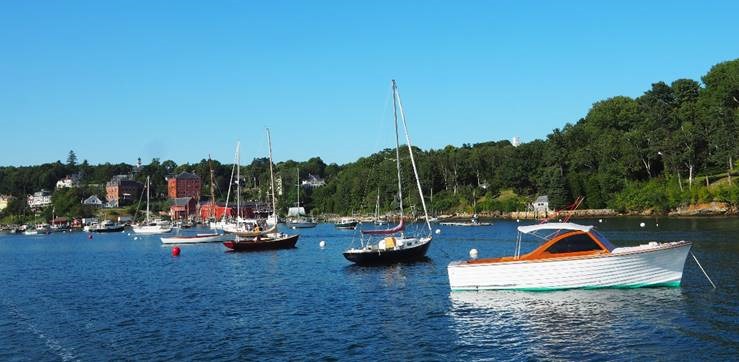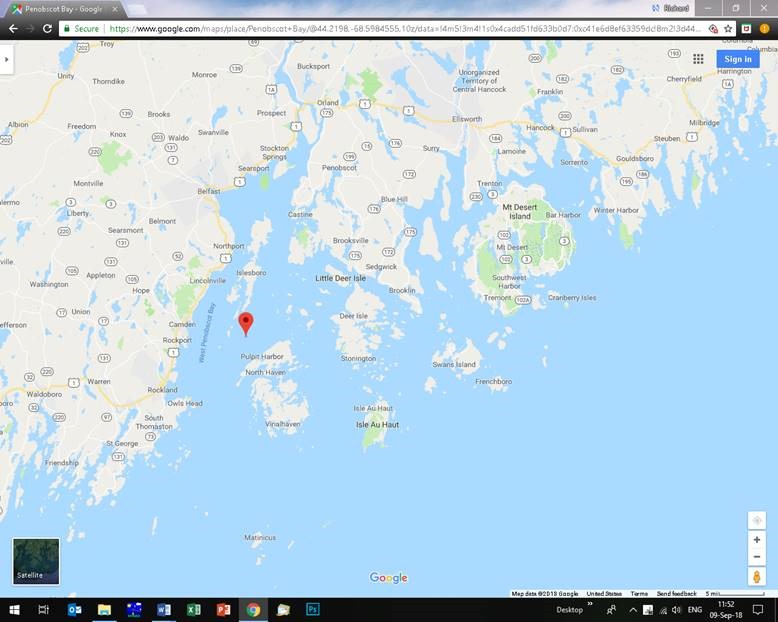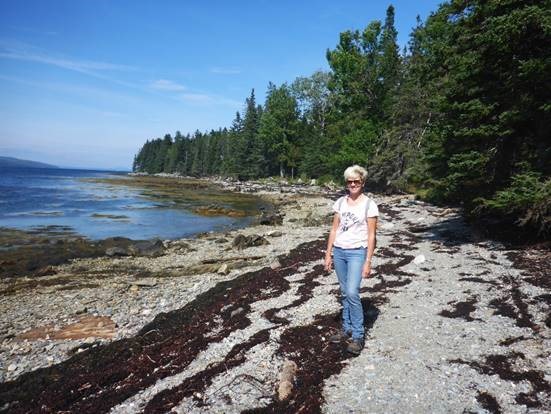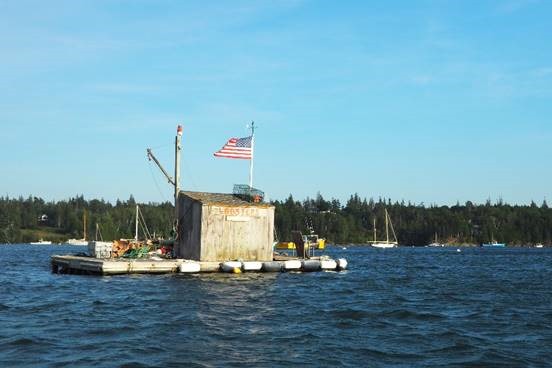4 Sept - Isles of Maine Part 1

|
44:09.22N 068: 53.1W We left Rockland on 31 August and spent the night back at anchor in Camden. It’s only a short sail and on the way up we nosed into Rockport for a look. Quieter than Camden and much smaller than Rockland, it’s a very picturesque little harbour dominated by well-maintained motor boats and yachts. The water is very deep, so unless you want to pick up a mooring, there are no realistic anchoring options. There’s a classic Maine boatyard at the top of the harbour with some fine craft hauled out for maintenance. It’s interesting to compare this coast to the English Channel harbours in particular. On the European side, recreational boating is concentrated in marinas, where the majority of sailing boats are white, glassfibre and either made in France or (if they are older) UK. Here, the majority of boats over trailerable size sit on moorings, primarily because the cost of an alongside berth is quite prohibitive.
Rockport, Maine But the biggest difference seems to be the type of boat: Americans owners are quite conservative, certainly where aesthetics are concerned. Most of the bigger motor boats north of the Chesapeake seem to fit into the ‘classic Gentleman’s cruising boat’ – none of your Sunseeker/Princess slab-sided financial statements here. Instead, they have embraced the more traditional fast fishing vessel generic shape and modernised it into a classic-looking, fairly high tech temple of gloss varnish. They look great and go well, but I wonder how well they would cope with the short, choppy seas of the English Channel? Probably as well as the Sunseekers do (which is why you mainly see them tied up in their marina berths)!
The exception that proves the rule… relocated from Florida - obviously! American sailing yachts follow a similar code, it seems. You rarely see a Beneteau or a Bavaria here. Instead, the majority of sailing vessels here look like a version of the Hinckley – on the face of it, not much change since the 1980s, although closer inspection reveals plenty of innovation in construction materials. It’s as though they realised they had a winning ‘look’ and have stuck with it. Secondhand prices here are eye-watering; I’ve seen nothing on the European side that holds its value as well as a well-built American yacht – motor or sail. There doesn’t seem to be the demand for the mass-produced cruising boats that you find in Europe. Whilst there is a huge market in USA for fast day-fishing boats that are easily stored on a trailer and towed behind the ubiquitous truck, fewer Americans seem interested in sailing; those who do are either on a tight budget and sailing something from the 1970s, or wealthy enough to support a heavy maintenance budget running a bespoke, classic-looking yacht. With the exception of Newport, I have not seen much evidence of yacht racing (although the dinghy scene is quite active) and the charter fleets of the Caribbean or the Mediterranean just do not seem to exist north of Key West. I wonder why?
Windjammers packed into Camden Harbour for the Labor Day weekend Saturday in Camden was dominated by the annual Windjammer festival, so the inner harbour was packed with late 19th and early 20th century working sailing vessels of one sort or another, making a fine spectacle. The waterfront was crowded too, helped by some glorious weather and the ‘Labor Day Weekend’. I’m glad we had not come by car as the roads were pretty solid, but we did manage to enjoy a surprisingly healthy cooked breakfast in a boutique ‘diner’ in the high street. Lobster crate races in the harbour were a good cue to depart though, and we had a very enjoyable sail across to the islands that cluster around Islesboro, on the west side of Penobscot Bay.
Islesboro is just to the north of the marker. Camden, Rockport and Rockland are to the west. We anchored on the western side of the group in Gilkey Harbour, as peaceful a place as you could find. There’s a three metre rise and fall of tide here, which is quite a lot by US Eastern seaboard standards, so we waited until nearer high water the following day to explore in the rubber dinghy and went ashore at Warren Island. This is a State Park with a few well-maintained camp sites, a good walking trail and not much else – apart from granite boulders, fir and birch trees, pine cones underfoot and that scent of conifer which clears the sinuses so gently. Just about every step offered a glimpse of open water, other islands and a mix of rocky and sandy shores. No cars, so the only visitors were relatively healthy… a significant proportion of the residents seemed interested in biting us though, so we regretted failing to apply mozzie-repellent before landing. Otherwise, pretty picture-perfect!
Julie at Warren Island, Islesboro. Compare with our 4 Feb article from Mustique? On Labor Day, we moved a few miles south east to the island of North Haven and another postcard anchorage, this time at Pulpit Harbour. Here there is more of a mix of commercial lobster fishing and recreational sailing, but the two seem to rub along together pretty well. The islanders seem to belong to one of those two categories – those of working age probably fish for a living, whilst the nicer houses are either holiday homes or occupied by retired folks from the Big Cities. The harbour has a number of deep inlets which we enjoyed exploring in the rubber boat; finding good walking trails ashore was more difficult. It’s quite hard to discern what’s public and what’s private on some of these islands, so rather than risk being shot by some arch misanthrope with an arsenal on his porch, we stuck to the roads.
Lobsters for sale in Pulpit Harbour! Note the ubiquitous Stars’n’Stripes and the easy chair to watch the view! |





